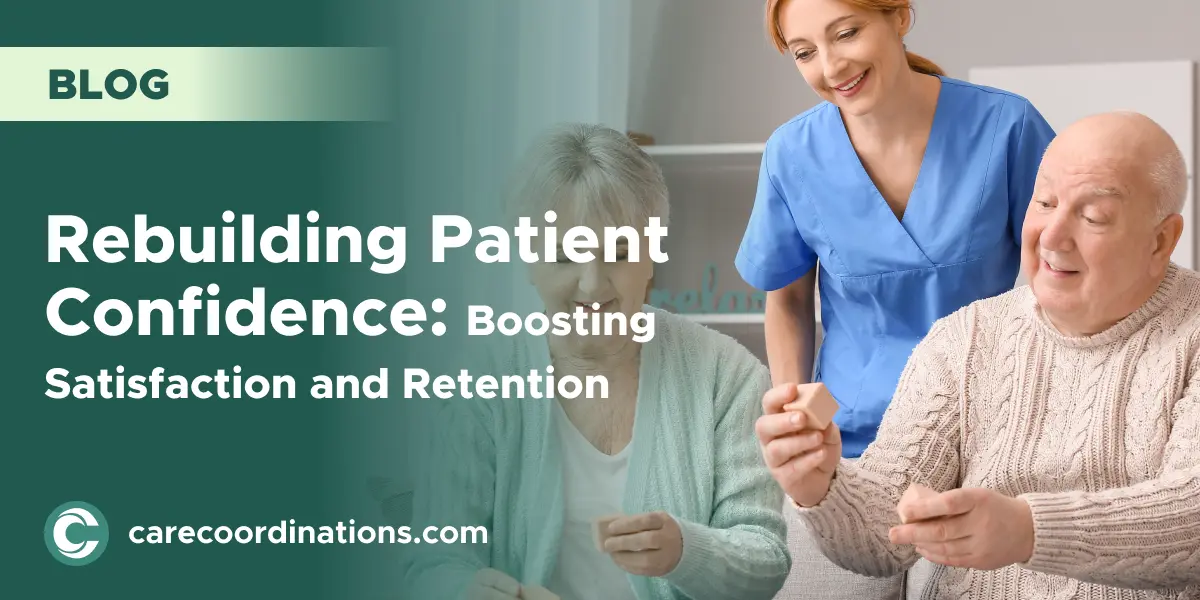Did you know patient confidence can drastically affect treatment outcomes and overall satisfaction? A confident patient is likelier to adhere to treatment plans, trust their healthcare providers, and feel satisfied with their care.
Patient confidence is a crucial element in the healthcare journey. It influences a patient's willingness to seek care, adherence to treatment plans, and overall satisfaction with the healthcare system. Rebuilding patient confidence is essential for improving patient outcomes and ensuring long-term retention.
This article explores the importance of patient confidence, the challenges in maintaining it, and how healthcare software solutions can help rebuild and boost it.
Understanding Patient Confidence
What is Patient Confidence?
Patient confidence refers to patients’ trust and assurance in their healthcare providers and the treatments they receive. It encompasses their belief in the competence and empathy of their medical team and the effectiveness of the prescribed medicines. When patients are confident, they are more likely to engage actively in their care, follow medical advice, and have better health outcomes.
Impact on Healthcare Outcomes
High levels of patient confidence lead to better adherence to treatment plans, increased patient engagement, and overall improved health outcomes.
According to a study published in the Journal of General Internal Medicine, patients with higher confidence levels are more likely to follow medical advice and experience better health results. Confidence in healthcare providers can also reduce anxiety and stress, leading to a more positive patient experience.
Also Read: How Palliative Care Software Supports Care Coordination and Communication
Current Challenges
• Common Issues Leading to Lack of Confidence
⇒ Lack of Clear Communication: Patients often feel left in the dark due to insufficient communication from their healthcare providers. Misunderstandings or lack of information can lead to clarity and trust.
⇒ Inconsistent Care: Variability in care quality and long wait times can erode patient trust. Patients may feel neglected or undervalued if they experience extended delays or inconsistent treatment.
⇒ Examples of Anecdotes: Consider a patient waiting weeks for a diagnosis, which can lead to frustration and decreased confidence in the healthcare system. Such experiences can discourage patients from seeking care in the future.
Recent studies reveal that nearly 30% of patients report dissatisfaction with their healthcare experiences, citing poor communication and lack of transparency as significant issues.
This dissatisfaction directly impacts patient retention rates, with many seeking alternative providers. A survey conducted by the American Medical Association found that 1 in 3 patients considered changing healthcare providers due to poor communication.
The Role of Healthcare Software Solutions
Enhancing Patient Communication
• Features of Effective Communication Tools
⇒ Secure Messaging Systems: These systems allow patients to communicate securely with their healthcare providers. Softaware enables timely responses to patient queries and concerns, fostering trust and confidence.
⇒ Automated Appointment Reminders: Help reduce no-show rates and inform patients about upcoming appointments. The software ensures patients feel valued and remembered, contributing to their confidence.
⇒ Real-Time Updates and Notifications: Keep patients updated about their treatment progress and any changes in their care plans. Providing real-time information helps patients feel more in control of their health.
Streamlining Administrative Processes
• Reducing Wait Times and Improving Scheduling
⇒ Online Scheduling Systems: Enable patients to book appointments conveniently, reducing wait times and administrative burdens. Patients can choose times that fit their schedules, leading to greater satisfaction and less frustration.
⇒ Efficient Patient Check-In Processes: Self-service kiosks and digital check-ins streamline the process, reducing waiting times and making it more efficient.
• Automated Reminders and Follow-Up Systems
Automated systems for appointment reminders and follow-ups help ensure patients don't miss their appointments and receive the necessary care. A study found that computerized reminders reduced no-show rates by 30%, leading to better continuity of care. These systems also send follow-up messages to check on patients after their visits, ensuring they feel cared for and supported.
Also Read: Transforming Chronic Care Management Through Mental Health Integration
Strategies to Boost Patient Confidence
Personalized Patient Care
• Tailoring Treatments to Individual Needs
Personalized care involves using patient data to tailor treatments to individual needs. Electronic Health Records (EHR) play a crucial role by providing healthcare providers comprehensive patient histories and preferences. Personalizing care plans based on individual needs makes patients feel understood and valued.
• Use of Patient Data
Data analytics can help create customized health plans. For instance, a hospital used patient data to develop personalized exercise and diet plans, which improved patient outcomes and satisfaction. By leveraging data, healthcare providers can offer more accurate diagnoses and effective treatments, enhancing patient confidence.
Transparency and Information Accessibility
• Easy Access to Medical Records
Patient portals and mobile apps provide easy access to medical records, allowing patients to stay informed about their health status. This transparency builds trust and confidence. Patients can review their test results, treatment plans, and medical histories, making them more engaged in their care.
• Educating Patients
Providing clear, understandable information about conditions and treatments empowers patients. Educational resources such as videos, articles, and interactive tools help patients make informed decisions about their care. Educated patients are more likely to follow treatment plans and feel confident in their healthcare providers.
Improved Patient Engagement
• Engaging Patients Through Technology
Interactive patient portals and mobile apps engage patients by providing them with tools to track their health, set medication reminders, and communicate with their healthcare team. Engaged patients are more proactive about their health and more likely to adhere to treatment plans.
• Encouraging Feedback and Participation
Collecting patient feedback through surveys and other means allows healthcare providers to understand patient needs better and make necessary improvements. Success stories of how feedback led to better care demonstrate the importance of patient participation. For example, a clinic that regularly solicited feedback from patients was able to implement changes that significantly improved patient satisfaction.
Technology-Driven Patient Support
Telemedicine and Virtual Care
• Benefits of Telemedicine
Telemedicine provides convenience and accessibility, particularly for patients in remote areas. It allows for timely consultations, reducing the need for travel and wait times. Telemedicine also offers flexibility, making it easier for patients to schedule appointments around their busy lives.
• Examples of Successful Implementations
A rural clinic implemented telemedicine services, resulting in a 40% increase in patient consultations. Patients reported higher satisfaction due to the convenience and ease of access to healthcare professionals. Additionally, telemedicine allowed for continuous monitoring and follow-ups, ensuring patients received ongoing care.
AI and Predictive Analytics
• Using AI to Predict Patient Needs
Predictive analytics helps identify at-risk patients and proactively manage their care. AI-driven tools analyze patient data to forecast potential health issues, allowing for early intervention. This proactive approach builds patient confidence as they feel their health is monitored closely.
• Enhancing Decision-Making
AI tools assist healthcare providers in making informed decisions by analyzing vast amounts of data. A hospital using AI for diagnostic purposes saw a 15% improvement in diagnosis accuracy and patient outcomes. AI can provide recommendations based on patterns and trends in patient data, leading to more effective treatments.
Also Read: Care Coordination and Quality Data: Key Factors in Growing Hospice Referrals
Future Trends in Patient Confidence and Satisfaction
Emerging Technologies
• Upcoming Innovations in Healthcare Software
Innovations such as blockchain for secure patient data management, virtual reality for patient education, and advanced AI for predictive analytics are set to revolutionize healthcare. These technologies will enhance patient confidence by providing more accurate diagnoses, personalized treatments, and improved overall care experiences.
• Impact on Healthcare Delivery
These technologies will change healthcare delivery, making it more efficient, transparent, and patient-centered. Adopting these technologies will increase patient confidence and satisfaction as patients experience more seamless and effective care.
Evolving Patient Expectations
• Trends in Patient Expectations
Modern patients expect transparency, personalized care, and easy access to their health information. Meeting these expectations is crucial for building and maintaining patient confidence. Healthcare providers must be proactive in understanding and addressing these evolving expectations.
• Staying Ahead in Patient Care
Healthcare providers must stay updated with industry trends and continuously improve their services to meet evolving patient expectations. Regular training and adoption of new technologies are essential. Healthcare providers can ensure they meet and exceed patient expectations by staying ahead of the curve.
Enhance Patient Confidence Today with Our Advanced Healthcare Software Solutions
Rebuilding patient confidence is vital for improving satisfaction and retention. Healthcare software solutions enhance communication, personalize care, and engage patients. Healthcare providers can significantly boost patient confidence and improve overall patient outcomes by addressing the challenges and leveraging technology.
Healthcare providers are encouraged to adopt the strategies discussed to rebuild patient confidence. For more information and assistance, explore our healthcare software solutions designed to enhance patient care and satisfaction.


